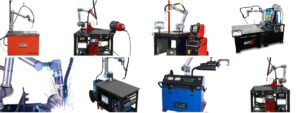At the heart of every manufacturing process lies the quest for productivity. Efficiency drives progress, and in the welding industry, this quest is no different. However, the landscape of welding is transforming, thanks to the integration of robotics. These automated marvels are reshaping traditional welding processes, ushering in an era of unprecedented speed, precision, and reliability.
Understanding Robotic Welding Systems
Robotic welding systems comprise a sophisticated ensemble of components meticulously designed to execute precise welds consistently. At its core lies the robotic arm, equipped with specialized welding tools. Supporting this arm is a network of sensors, controllers, and actuators, orchestrating a symphony of movements with unparalleled accuracy.
Welding robot technology boasts an array of advantages over its manual counterpart. By harnessing the power of automation, these systems eliminate the variability inherent in human labour, ensuring each weld meets exacting standards. Furthermore, the ability to program precise parameters enables robotic welders to replicate flawless results time and again.
Improving Efficiency through Robotic Welding
Robotic welding systems are synonymous with speed and precision, offering a quantum leap in efficiency. Unlike human welders, robots operate tirelessly without succumbing to fatigue or distractions. This relentless pace translates into accelerated production cycles, empowering manufacturers to meet demanding deadlines with ease.
Human error is an unavoidable facet of manual welding, often leading to costly rework and delays. However, robotic welders mitigate this risk by executing each weld with unwavering precision. By adhering to predefined parameters, these systems eliminate variability, ensuring every weld meets exacting quality standards.
Consistency is the cornerstone of quality, and robotic welding systems deliver consistency in abundance. By adhering to meticulously programmed parameters, these systems produce welds of unparalleled uniformity, free from the imperfections that plague manual welding processes. The result is a superior product devoid of defects and inconsistencies.
Increasing Throughput with Robotics
Robotic welding systems boast the remarkable capability for continuous operation, operating tirelessly around the clock without succumbing to fatigue. This uninterrupted production translates into a dramatic increase in throughput, allowing manufacturers to meet growing demand without compromise.
Robotic welders are adept multitaskers, capable of seamlessly transitioning between various welding tasks with ease. This versatility enables manufacturers to optimize production processes, maximizing efficiency without the need for additional resources. Whether welding intricate components or assembling large structures, robotic systems excel in multitasking mastery.
One of the defining characteristics of robotic welding systems is their scalability and flexibility. These systems are easily adaptable to a myriad of welding tasks, from small-scale projects to large-scale production runs. Furthermore, advancements in robotic technology have ushered in a new era of flexibility, enabling manufacturers to reconfigure systems to accommodate evolving production needs effortlessly.
Cost-Effectiveness of Robotic Welding Solutions
While the initial investment in robotic welding systems may seem daunting, the long-term savings far outweigh the upfront costs. By streamlining production processes and eliminating costly errors, these systems deliver a compelling return on investment, driving down operational expenses and bolstering the bottom line.
Labour constitutes a significant portion of welding expenses, but robotic welding systems have the potential to reduce these costs dramatically. By automating repetitive tasks and minimizing the need for manual intervention, these systems enable manufacturers to optimize labour resources, reallocating personnel to more value-added activities.
Enhancing Workplace Safety
Safety is paramount in the welding industry, and robotic welding systems offer a compelling solution to mitigate workplace hazards. By assuming the lion’s share of welding tasks, these systems minimize human exposure to hazardous environments, reducing the risk of injury and illness among workers.
Robotic welding systems boast advanced remote monitoring and operation capabilities, enabling operators to oversee production processes from a safe distance. This remote accessibility not only enhances worker safety but also facilitates real-time troubleshooting and maintenance, ensuring optimal system performance at all times.
In an industry rife with regulations and standards, compliance is non-negotiable. Fortunately, robotic welding systems are designed with safety and regulatory compliance in mind, adhering to stringent guidelines to safeguard both workers and assets. This commitment to compliance provides peace of mind, assuring manufacturers that their operations are conducted in accordance with the highest safety standards.
Overcoming Challenges and Implementation Strategies
The integration of robotic welding systems necessitates a shift in workforce dynamics, requiring upskilling and retraining to harness the full potential of these technologies. By investing in comprehensive training programs, manufacturers can empower their workforce to embrace automation, fostering a culture of innovation and continuous improvement.
Integration is critical to the successful implementation of robotic welding systems, requiring careful planning and execution. By collaborating closely with technology partners and suppliers, manufacturers can ensure a seamless transition from manual to automated processes, minimizing disruption and maximizing efficiency.
Despite the myriad benefits of robotic welding systems, concerns regarding job displacement and workforce adjustments persist. However, by emphasizing the role of automation as a complement rather than a replacement to human labour, manufacturers can assuage these concerns, highlighting the potential for upskilling and redeployment within the organization.
Conclusion
The integration of robotic welding systems heralds a new era of efficiency and productivity in the welding industry. By harnessing the power of automation, manufacturers can unlock unprecedented speed, precision, and reliability, driving tangible improvements in quality, throughput, and cost-effectiveness. As we look to the future, the possibilities are limitless, with robotics poised to reshape the very fabric of welding as we know it.




0 Comments